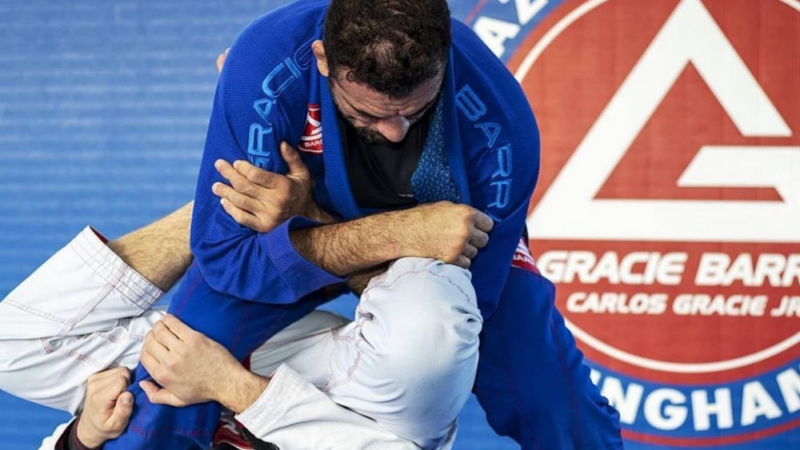Guest post by Evolve MMA, Asia’s premier championship brand for martial arts. It has the most number of World Champions on the planet. Named as the #1 ranked martial arts organization in Asia by CNN, Yahoo! Sports, FOX Sports, Evolve MMA is the top rated BJJ gym in Singapore.
The Estima Lock, named after Brazilian Jiu-Jitsu practitioners and brothers Victor and Braulio Estima, is a unique and absolutely nasty foot lock submission. It targets the opponent’s foot, specifically the ankle, and can be applied from various positions. Today’s article explores the mechanics, applications, defenses, and viability of the Estima Lock in Jiu-Jitsu.
Leg Locks In Today’s Game
If you are wondering if you really need to study leg locks, the answer is yes. The modern approach to Jiu-Jitsu is where you have to be knowledgeable in practically all positions, meaning that having several leg attacks is always a smart and helpful idea. This is especially important in No-Gi (Submission grappling), as many of today’s competitors are fierce leg lockers. The Estima lock is a great technique that’s sure to improve your game.
Mechanics Of The Estima Lock
The Estima Lock is a foot lock that primarily targets the ankle, applying pressure in a twisting-like motion. The practitioner controls the opponent’s foot by gripping it with both hands, with one hand controlling the toes and the other controlling the heel. The foot is then twisted and pressured against the practitioner’s chest, creating a torque that affects the ankle joint. The mechanics of the Estima Lock are somewhat similar to the traditional toe hold but with distinct differences in grip and application.
The Estima Lock In Action
In this video, BJJ legend and multiple-time world champion Braulio Estima shares the basics of the Estima lock. He recommends using misdirection as a tool to hide the submission. He mentions that a good way to attack the Estima lock is when you threaten a pressure pass, especially with techniques like the knee cut pass and hug pass. The opponent’s typical reaction to these passes is to base and push your midsection. When this happens, you can drop back and attack with the Estima lock. Don’t forget to keep a tight grip on the foot using the RNC grip so that you can minimize foot slips.
Applications And Positions
The Estima Lock can be applied from various positions, making it a versatile submission. Similar to the toehold, where you don’t have to enter into a deep leg entanglement, the Estima lock is available in many positions, provided that the opponent’s foot is near your midsection. That said, here are a couple of common scenarios:
1) From Open Guard
When playing open guard, you can control the opponent’s foot by forcing them to push back, and, from there, transition into the Estima Lock, especially if the opponent is careless with their foot placement.
2) During Guard Passing
While attempting to pass the guard, you can catch the opponent’s foot in a similar manner to the one above and apply the Estima Lock, using it as a submission or a distraction to complete the guard pass.
3) From 50/50 Guard
The 50/50 guard position offers opportunities to attack the feet, and the Estima Lock can be a powerful option from this position. It is always a good idea to chain leg attacks from the 50/50, as with any other leg entanglement position.
4) In No-Gi Grappling
The Estima Lock is also applicable in No-Gi grappling, where the absence of the gi allows for more fluid movement and transitions to foot locks. Note that the lack of gi can also make things slippier, making the initial catch harder to do.
Defenses And Escapes
Like any submission, the Estima Lock has defenses and escapes. Recognizing the attack early on is crucial, as it allows the defender to react before the submission is fully locked in. Below are some common defenses you can do:
1) Foot Retraction
Pulling the foot away before the attacker secures the grip can prevent the Estima Lock. The key here is pulling your foot out before the lock is tight.
2) Rolling Escape
Rolling in the direction of the pressure can alleviate the torque and allow the defender to escape. The lack of leg entanglement in the Estima lock makes it vulnerable to the rolling escape in many ways.
3) Counter Attacks
A skilled defender may also counter with their own foot lock or even transition to a better position. This is less common than the first two, but it is best to be mindful, nevertheless.
Understanding these defenses is essential for both applying the Estima Lock effectively and defending against it. As you get better with the submission, you should be able to think several steps ahead of your opponent based on how they react to your attacks.
History And Legacy
The Estima Lock is named after the Estima brothers, Victor and Braulio Estima, accomplished Jiu-Jitsu practitioners and instructors from Brazil. They developed and popularized this unique submission in the mid-2000s and have successfully used it in the highest levels of the sport. Even today, the Estima Lock is commonly seen in various competitions, including prestigious events like the World Championships. Its effectiveness and uniqueness have made it a timeless technique that will be used for future generations.
Considerations
Leg locks, including the Estima Lock, can be controversial in some BJJ circles. The potential for injury, mainly if applied recklessly, has led to debates about the appropriateness of foot attacks in specific settings, such as training with white belt-level students. Proper instruction, control, and consideration for training partners are vital to ensure that the Estima Lock is applied safely and responsibly. As mentioned, the best way to stay safe is to understand the technique’s application and defense.
Conclusion
The Estima Lock is a fascinating and practical submission in Brazilian Jiu-Jitsu. Its unique mechanics, application versatility, and rich history make it a valuable addition to any BJJ practitioner’s toolbox. Whether used as a primary attack or a complementary technique, the Estima Lock offers opportunities to control, submit, or transition against opponents.
Understanding the Estima Lock requires study, practice, and guidance from knowledgeable instructors. It’s a technique that rewards precision as well as proper timing to pull off. As with all BJJ techniques, the Estima Lock should be practiced cautiously. Respect the safety of your training partners at all times.
The Estima Lock’s contribution to the sport of BJJ is a testament to the creativity and innovation that characterizes Brazilian Jiu-Jitsu. Whether you’re a competitor seeking an edge or a hobbyist exploring the depth of the art, the Estima Lock is always a welcome technique to learn.
Learn And Master The Most Unique Footlocks From The Multiple ADCC And World Champion Who Invented Them.
Braulio Estima Is Here To Walk You Through Developing A Lethal, Simple, And Devastating Lower Body Submission Game
Braulio Estima is a multiple time ADCC Champion and multiple time Black Belt World Champion who has wins over some of the best in the world including Marcelo Garcia.
Braulio has spent years refining this technique and has been able to utilize it successfully at the highest levels of competition.




















